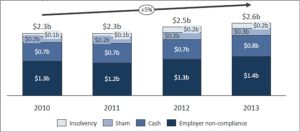Non-payment in large-scale infrastructure development projects poses significant challenges that can hinder progress and impact the overall success of the projects. In this article, we will explore the impact of non-payment on projects, the legal and regulatory framework surrounding non-payment, and the importance of upholding contractual obligations. We will also delve into effective mitigation strategies, such as risk assessment and management, negotiation and dispute resolution, and the value of collaborative partnerships. Through case studies and best practices, we will examine successful resolution models, lessons learned, and industry recommendations for addressing non-payment in infrastructure development.
Key Takeaways
- Effective risk assessment and management are crucial in mitigating the impact of non-payment on infrastructure projects.
- Negotiation and dispute resolution play a key role in addressing non-payment issues and ensuring project continuity.
- Collaborative partnerships can help mitigate the impact of non-payment by leveraging collective resources and expertise.
- Successful resolution models highlight the importance of proactive measures and clear contractual frameworks in addressing non-payment.
- Lessons learned from past experiences can inform better practices and strategies for tackling non-payment in large-scale infrastructure development.
Challenges in Infrastructure Development
Impact of Non-Payment on Projects
Non-payment is a critical issue that can derail even the most meticulously planned infrastructure projects. Cash flow interruptions can lead to a cascade of setbacks, from halted construction to strained supplier relationships.
Delays and cost overruns are often the immediate consequences, impacting not just the project timeline but also its financial viability. The ripple effects extend to all stakeholders, including contractors, investors, and the community at large.
- Project delays
- Increased costs
- Legal disputes
- Loss of investor confidence
The sustainability of infrastructure development hinges on the reliable flow of funds. Non-payment is not merely an inconvenience; it is a potent threat to project completion and success.
Legal and Regulatory Framework
The legal and regulatory framework sets the foundation for infrastructure development. Clear regulations and robust legal systems are crucial to enforce contracts and address non-payment issues.
- Understanding local and international laws is imperative.
- Compliance with regulations ensures project legitimacy.
- Legal recourse provides a safety net for stakeholders.
Regulatory bodies play a pivotal role in maintaining fair practices and mitigating risks.
In the event of non-payment, the legal framework offers mechanisms for resolution. It is essential for parties to be aware of their rights and the procedures to follow, ensuring that disputes are handled efficiently and effectively.
Contractual Obligations
In the realm of large-scale infrastructure development, contractual obligations serve as the backbone of project execution. Clear, comprehensive contracts are essential to delineate responsibilities, timelines, and payment terms.
- Risk Allocation: Contracts must explicitly define risk sharing between parties.
- Payment Mechanisms: Detailed clauses on payment schedules prevent ambiguity.
- Performance Guarantees: These ensure commitment to project milestones.
Ensuring that contracts are enforceable and include mechanisms for addressing non-payment is crucial for project continuity.
Failure to adhere to contractual terms can lead to disputes, project delays, and financial losses. Therefore, stakeholders must prioritize contract management and enforceability to safeguard their interests.
Mitigation Strategies
Risk Assessment and Management
Identifying potential risks early in the project lifecycle is crucial for mitigating non-payment issues. A comprehensive risk assessment should be conducted, considering factors such as the financial stability of stakeholders, political climate, and market volatility.
Preventative measures are more effective than reactive solutions. Establishing clear risk management protocols can help in anticipating challenges and formulating appropriate responses. This includes regular financial health checks of partners and rigorous contract terms that protect against default.
- Develop a risk matrix to categorize and prioritize risks
- Assign risk ownership to ensure accountability
- Regularly update risk assessments to reflect changing conditions
Effective risk management is not just about avoidance; it’s about creating a resilient framework that allows for flexibility and adaptability in the face of unforeseen challenges.
Negotiation and Dispute Resolution
Effective negotiation and dispute resolution are critical to maintaining project momentum in the face of non-payment challenges. By prioritizing these strategies, stakeholders can avoid costly delays and litigation.
- Early engagement with all parties to understand perspectives and interests.
- Development of a clear negotiation strategy, including fallback positions.
- Use of professional mediators or arbitrators to facilitate discussions.
Ensuring that negotiation and dispute resolution mechanisms are built into contracts can provide a clear pathway to resolving issues before they escalate.
The success of these approaches hinges on the willingness of parties to compromise and find mutually beneficial solutions. It is not just about enforcing contractual rights but also about preserving business relationships and ensuring the continuity of the project.
Collaborative Partnerships
In the realm of large-scale infrastructure development, collaborative partnerships stand as a cornerstone for mitigating non-payment risks. These alliances foster a shared commitment to project success and financial integrity.
Joint ventures and strategic alliances can distribute risks and responsibilities, ensuring that all parties have a vested interest in the project’s financial health. By pooling resources and expertise, partners can better navigate the complexities of large-scale projects.
- Establish clear communication channels
- Define roles and responsibilities
- Set mutual goals and objectives
Effective collaboration hinges on transparency and trust. Regular meetings and updates can preempt misunderstandings and facilitate a proactive approach to potential payment issues.
The synergy of a well-orchestrated partnership often translates into a robust defense against the pitfalls of non-payment, ultimately contributing to the project’s resilience and success.
Case Studies and Best Practices
Successful Resolution Models
Public-Private Partnerships (PPPs) have emerged as a successful model in mitigating non-payment risks. These arrangements leverage the strengths of both sectors to ensure project completion and financial stability.
Transparency in communication and financial dealings is key to the success of these models. It fosters trust and reduces the likelihood of disputes that can lead to non-payment scenarios.
By aligning incentives and sharing risks, PPPs can effectively tackle the challenges of non-payment, ensuring that infrastructure development progresses smoothly.
- Establish clear roles and responsibilities
- Set realistic payment schedules
- Implement robust monitoring and reporting systems
The table below illustrates the impact of successful resolution models on project completion rates:
| Model Type | Completion Rate |
|---|---|
| Traditional | 75% |
| PPP | 90% |
Lessons Learned
In the realm of large-scale infrastructure development, the repercussions of non-payment are not merely financial but can also lead to a cascade of project delays and legal entanglements. Timely resolution of payment disputes is crucial to maintaining project momentum and stakeholder relationships.
Communication is the linchpin in preempting non-payment issues. Regular, transparent dialogue between parties helps identify potential problems early, allowing for proactive measures to be taken.
Effective project management hinges on the anticipation of risks and the implementation of robust financial controls.
- Establish clear payment terms upfront
- Conduct thorough due diligence on all parties
- Maintain meticulous records of work completed and payments due
The synthesis of these lessons into standard operating procedures can significantly mitigate the risks associated with non-payment.
Industry Recommendations
In the realm of large-scale infrastructure development, timeliness is paramount. Effective communication channels must be established to ensure all stakeholders are aligned and informed.
- Prioritize transparency in financial dealings.
- Establish clear payment milestones.
- Foster a culture of accountability.
Embrace innovation in project financing and payment mechanisms to stay ahead of potential non-payment issues.
Adherence to these industry recommendations can significantly reduce the risk of non-payment, ensuring that projects are delivered on time and within budget.
Frequently Asked Questions
What are the common challenges in infrastructure development?
The common challenges in infrastructure development include the impact of non-payment on projects, navigating the legal and regulatory framework, and meeting contractual obligations.
How can non-payment affect large-scale infrastructure projects?
Non-payment can lead to project delays, financial strain on contractors and suppliers, and overall project instability.
What are the key components of risk assessment and management in infrastructure development?
Risk assessment and management involve identifying potential risks, evaluating their impact, and implementing strategies to mitigate or transfer the risks.
How can collaborative partnerships help address non-payment issues in infrastructure projects?
Collaborative partnerships can provide mutual support, shared resources, and collective advocacy to address non-payment issues and promote fair practices in infrastructure development.
What are some successful resolution models for non-payment disputes in infrastructure projects?
Successful resolution models may involve mediation, arbitration, or other alternative dispute resolution methods to reach fair and timely resolutions.
What industry recommendations can help prevent non-payment issues in large-scale infrastructure development?
Industry recommendations may include transparent payment processes, clear contractual terms, and proactive risk management strategies to prevent non-payment issues.





